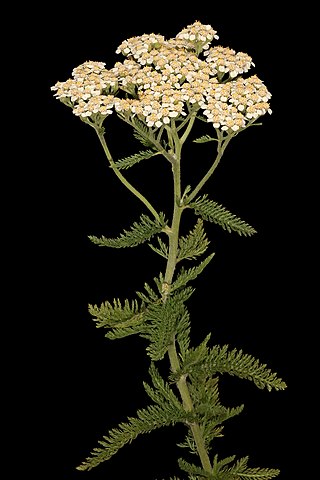
Achillea millefolium, commonly known as yarrow or common yarrow, is a flowering plant in the family Asteraceae. Other common names include old man's pepper, devil's nettle, sanguinary, milfoil, soldier's woundwort, and thousand seal.
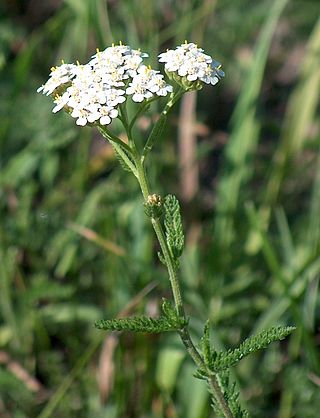
Achillea is a genus of flowering plants in the family Asteraceae, known colloquially as yarrows. The plants typically have frilly leaves. The common name "yarrow" usually refers to A. millefolium. The genus was named after the Greek mythological character Achilles, whose soldiers were said to have used yarrow to treat their wounds; this is reflected by common names such as allheal and bloodwort. The genus is native primarily to Eurasia and North America.
Yarrow is a plant in the family Asteraceae.

Haemodoraceae is a family of perennial herbaceous flowering plants with 14 genera and 102 known species. It is sometimes known as the "bloodroot family". Primarily a Southern Hemisphere family, they are found in South Africa, Australia and New Guinea, and in the Americas. Perhaps the best known are the widely cultivated and unusual kangaroo paws from Australia, of the two closely related genera Anigozanthos and Macropidia.
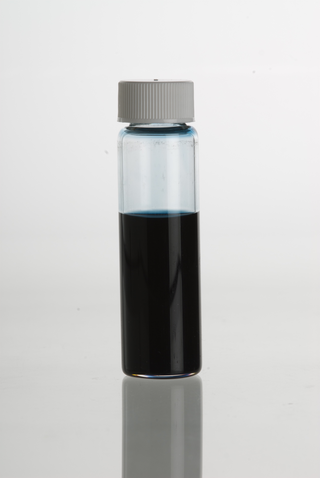
Yarrow essential oil is a volatile oil including the chemical proazulene. The dark blue essential oil is extracted by steam distillation of the flowers of yarrow.
Milfoil is a common name for several plants and may refer to:
Woundwort is the common name for several species of plants and may refer to:

Achillea filipendulina, the yarrow, fernleaf yarrow, milfoil, or nosebleed, is an Asian species of flowering plant in the sunflower family, native to central and southwestern Asia. It is also naturalized in parts of Europe and North America.

Achillea nobilis, the noble yarrow, is a flowering plant in the sunflower family. It is native to Eurasia, widespread across most of Europe and also present in Turkey, the Caucasus, and Central Asia. It is reportedly present in Xinjiang Province in western China, but this is based on a single herbarium specimen collected in the 19th century. The species is widely cultivated and has become naturalized outside of its range in North America and other parts of the world.

Antennaria rosea is a North American species of flowering plant in the family Asteraceae known by the common name rosy pussytoes. Other common names include cat's foot and mountain everlasting. The second part of its scientific name, rosea, is Latin for pink. It is widespread across much of Canada including all three Arctic territories, as well as Greenland, the western and north-central United States, and the Mexican state of Baja California.

Symphyotrichum pilosum is a perennial, herbaceous, flowering plant in the Asteraceae family native to central and eastern North America. It is commonly called hairy white oldfield aster, frost aster, white heath aster, heath aster, hairy aster, common old field aster, old field aster, or steelweed. It may reach 20 to 120 centimeters tall, and its flowers have white ray florets and yellow disk florets.

Chamazulene is an aromatic chemical compound with the molecular formula C14H16 found in a variety of plants including in chamomile (Matricaria chamomilla), wormwood (Artemisia absinthium), and yarrow (Achillea millefolium). It is a blue-violet derivative of azulene which is biosynthesized from the sesquiterpene matricin.

Achillea ageratifolia, the Balkan yarrow or Greek yarrow, is a species of flowering plant in the daisy family Asteraceae, native to Greece and Bulgaria. Growing to 20 cm (7.9 in) tall and broad, it is a compact herbaceous perennial. It is a highly variable species, with three recognized subspecies. They have erect, simple, somewhat woody based stems. The narrow grey-green foliage resembles that of a related genus Ageratum, hence the Latin specific epithet ageratifolia. The solitary, daisy-like composite flower heads are white with yellow centres and about 2–3 cm across. They appear May–July in the northern hemisphere.

Coleophora argentula is a moth of the family Coleophoridae, found in most of Europe, Russia and Asia Minor.

Potentilla hippiana is a species of flowering plant in the rose family known by the common names woolly cinquefoil, horse cinquefoil, and Hipp's cinquefoil. It is native to North America, where it occurs in western Canada and the western United States. It occurs in eastern Canada and the US state of Michigan as an introduced species.

The Telkkämäki Nature Reserve is an open-air museum and a heritage farm in the municipality of Kaavi, in the Northern Savonia region of Finland. It covers one square kilometer.

Megalocoleus molliculus is a species of plant bug in the family Miridae. It is found in Europe and east through the Palearctic to Siberia. It also occurs in North America.
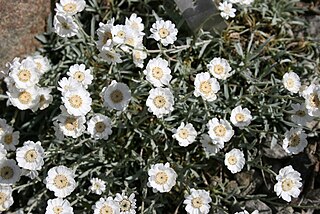
Achillea cretica, Cretan yarrow, is a species of flowering plant in the family Asteraceae, native to Greece, the East Aegean Islands, Crete, Turkey, and Cyprus. It is typically found in calcareous rocky areas such as cliffs, gorges, scree fields, and even ancient ruins, and is somewhat tolerant of salty conditions.
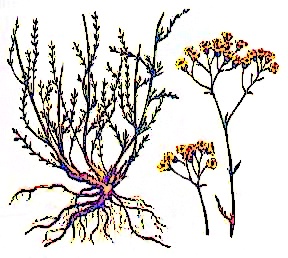
Achillea glaberrima is a species of yarrow in the family Asteraceae, native to southeastern Ukraine. A cultivar, 'Gold Spray', is available.

















